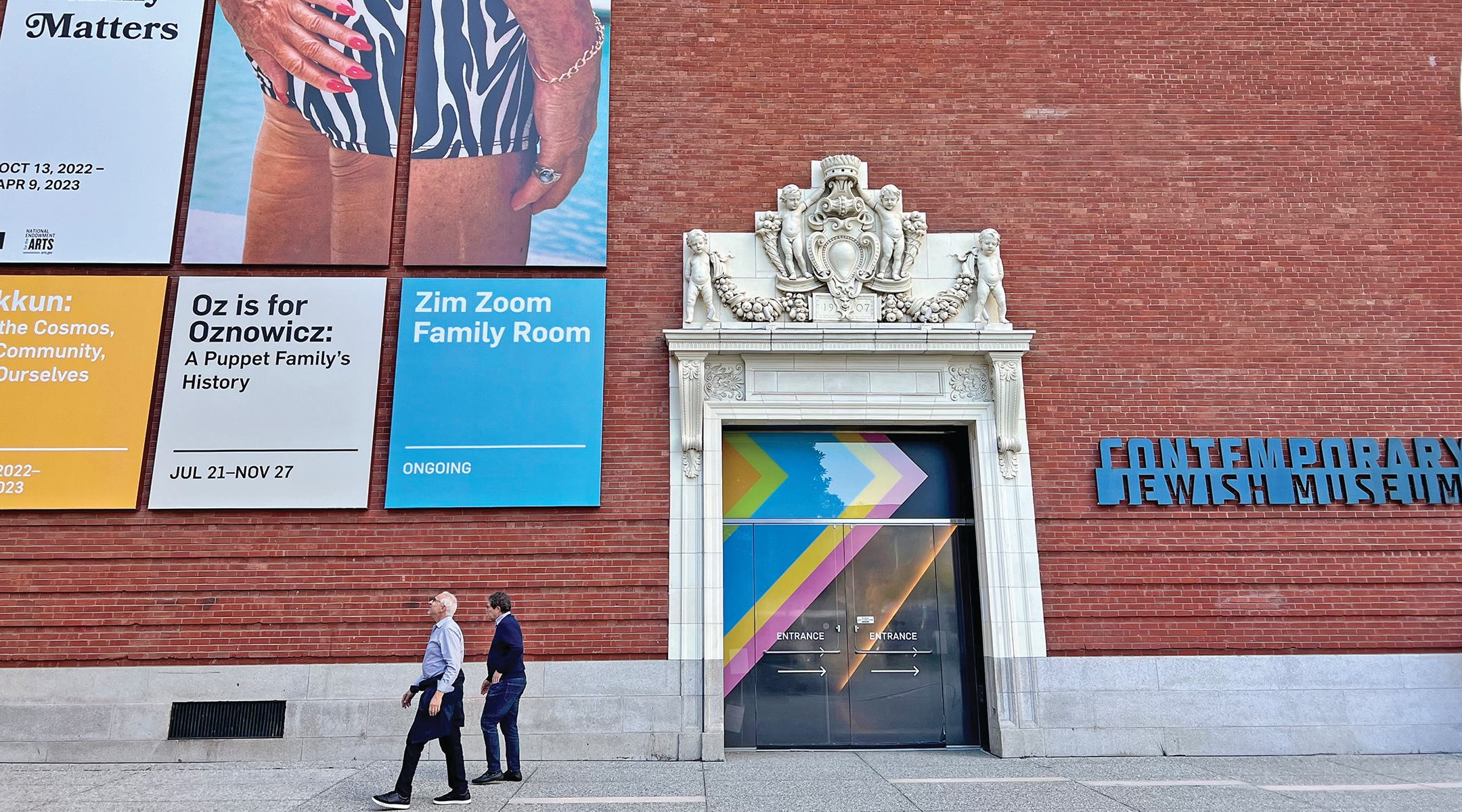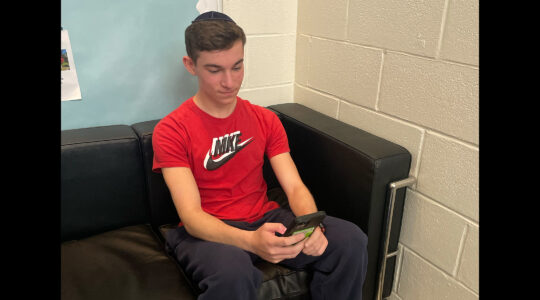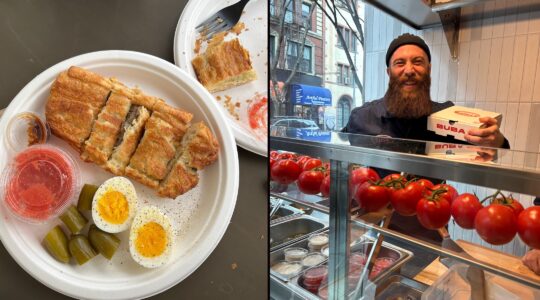(J. The Jewish News of Northern California via JTA) — Tucked in the far corner of a large, brightly-lit exhibition hall on the ground floor of the Contemporary Jewish Museum in San Francisco, there is a delicate-looking piece of art with a strong political message.
At first glance, it appears to be three circular vases with flowers in them. The ceramic vases sit on shelves attached to the wall, and colorful collages hang above them. On closer inspection, visitors will notice that the flowers are made out of paper and that affixed to each vase is an image of the Palestinian flag printed on foam board.
A nearby label written by the curators of the exhibit, titled “Tikkun: For the Cosmos, the Community, and Ourselves,” explains that the piece was inspired by a conversation the artist, Tosha Stimage of Berkeley, had with a Palestinian man. He told Stimage about the plants that are native to Palestine — “a place which he can no longer access due to the ongoing conflict in the region,” the curators write.
The label also includes a note about the flag: “Some may find its presence at The CJM troubling or confusing, while others may find it appropriate and forthright. Stimage recognizes the potential for these divergent responses and hopes to use them as a means of generating dialogue.”
On a Sunday afternoon in October, Maury Ostroff read the label and walked away without inspecting the artwork.

Visitors to the “Tikkun” exhibit are encouraged to share their responses to the artwork via comment cards. (Andrew Esensten)
Asked how the presence of the flag made him feel, Ostroff, who is Jewish and lives in Muir Beach, in Marin County, replied, “Unhappy.”
Why?
“It’s not offensive to me in the same way that a swastika is. My skin is a little bit thicker than that. But I wish it weren’t here.”
He added, “What’s so Jewish about this? What’s so ‘tikkun olam’ about all of this?”
For the “Tikkun” exhibit, which opened Feb. 17 and runs through Jan. 8, the CJM invited both Jewish and non-Jewish Bay Area artists to contribute new works on the theme of repair, however they chose to interpret it. “No one is listening to us,” the piece by Stimage, who is not Jewish, is the first work of art featuring the Palestinian flag to be shown at CJM in recent memory; the museum could not say when or if the flag has been displayed on its walls before.
The piece prompted several internal conversations among CJM staff when it was first submitted and, since it has been on display, has generated a variety of responses from museumgoers who have left comments in a box at the entrance to the exhibit. Intentionally or not, Stimage has raised numerous questions with the artwork, including: Does a work of art that is sympathetic to the Palestinian struggle for statehood belong in a Jewish museum? And what is the role of a contemporary Jewish museum, anyway?
“To truly be a contemporary art museum, meaning embedded in the contemporary issues of our day, our job is to provide a platform for dialogue and to share a diversity of perspectives on our walls,” said Chad Coerver, CJM’s executive director since September 2021. “If any institution [like ours] took the path of withholding artwork that troubled our staff, our board or our community, it would be very difficult to mount exhibitions.”
CJM is a member of the Council of American Jewish Museums, a network of 76 museums across the country. CAJM does not have guidelines about the kind of art its member museums can and cannot display, according to Executive Director Melissa Yaverbaum.
J. reached out to several CAJM member museums in New York, Los Angeles and other places by email to ask if they had ever shown artwork with Palestinian iconography or works by Palestinian artists. The museums declined to answer or did not respond.
In recent years, two Jewish museums have been embroiled in controversy over issues relating to the Israeli-Palestinian conflict. The Spertus Institute for Jewish Learning and Leadership in Chicago staged an exhibit in 2008 on Israeli and Palestinian concepts of homeland that included maps and portraits of Palestinians. Following outcry from members of the local Jewish community who felt the exhibit presented Israel in a negative light, the museum decided to close the exhibit after only a few weeks. And in 2019, the director of the Jewish Museum Berlin resigned after the museum tweeted a link to a pro-BDS article in a German newspaper. (The museum previously came under fire for welcoming anti-Zionist scholar Judith Butler and representatives of Iran.)
In a joint interview with J., two CJM staffers who worked on “Tikkun” — co-curator Qianjin Montoya, who is not Jewish, and a Jewish senior curator who served in an advisory role, Heidi Rabben — shared the story of how Stimage’s piece came to be in the exhibit. (Montoya’s co-curator for the exhibit, Arianne Gelardin, no longer works at the museum.)
Since 2009, CJM has invited local artists from different backgrounds to create new work as part of the museum’s annual Dorothy Saxe Invitational. The idea for “Tikkun” was hatched before the pandemic put the planning process on hold. Once the CJM and Saxe — a local philanthropist and art collector — agreed on the theme, the co-curators invited artists “already engaged in healing through their relationship to community or in their practice of daily life,” Gelardin told J. last February.
The 30 artists who accepted the museum’s invitation were given only four months to conceive of and submit new works. That was likely the shortest timeline in the history of the invitational, which has been held 11 previous times, according to the museum. Each artist received a packet of materials compiled by CJM staff, with input from the Shalom Hartman Institute, a non-degree granting Jewish education center, to guide their thinking on “tikkun.”
Stimage was invited to participate because she is “very active” in the Bay Area and because “her work reflects ideas of community and connection,” Montoya said.
The curators said Stimage’s inclusion of the Palestinian flag in her submitted piece came as a surprise and prompted challenging conversations. However, they noted that they found the content of some of the other artists’ work surprising, too, and that it’s not unusual for contemporary artists to push the envelope in their work.
“I wouldn’t say we expected to receive a piece about the Israeli-Palestinian conflict, but we weren’t steering anyone away from that, either,” Rabben told J., adding that the submission guidelines did not place any topic off limits. “That’s a commitment from the museum to authentically represent the creative spirit of the artists that we’re working with,” she said.
Still, the curators said they engaged in a dialogue with Stimage in order to better understand each aspect of her piece and her overall intentions. Through those conversations, the curators learned that Stimage wanted to explore a moment of “rupture,” and that through her piece she hoped to communicate “that before healing or repair might happen, you have to first acknowledge that rupture,” Rabben said.

The Contemporary Jewish Museum in San Francisco is showing “Tikkun,” an exhibit of works by Jewish and non-Jewish artists on the theme of repair. (Andrew Esensten)
Coerver, who was involved in some of the conversations, stressed that “careful consideration” was given to including the piece in the exhibit. “We felt an artwork addressing the plight of the Palestinians was appropriate in an exhibition on healing and repair,” he said. (No work submitted as part of the Dorothy Saxe Invitational has ever been outright rejected, the museum said.)
Stimage did not respond to interview requests from J. According to a CV on her website, she was born in Jackson, Mississippi, and earned an MFA from California College of the Arts in 2016. She is a past fellow at the Yerba Buena Center for the Arts in San Francisco and was an artist-in-residence at Facebook in 2018. She also owns a floral gift shop in Oakland called Saint Flora.
Her work often touches on Black identity; she created a piece honoring Sandra Bland, an African-American woman whose 2015 arrest and death in a Texas jail cell sparked protests, and contributed to a 2019 San Francisco Art Institute exhibit on the Black Panther Party.
“I have a responsibility to create things that will, to the best of my present knowledge, do more good than harm, heal, inspire and uplift other humans,” she told the San Francisco Bay View National Black Newspaper in 2015.
Stimage’s precise views on Israel are unknown. CJM referred J. to her artist statement for “No one is listening to us,” which reads: “Olive, sage, and sumac are flowering plants native to the Mediterranean (including regions of Gaza and the West Bank) that have a direct relationship to contested ancestral land and affect the livelihood of so many Palestinian farmers and families caught in the conflict. They are positioned in the space of The Contemporary Jewish Museum as a metaphor for the ongoing conflict over land rights and the desperate need for restoration and healing of an age-old wound.”
The curators told J. that during their conversations with Stimage about her piece, they asked her why including images of the Palestinian flag was important to her but did not request that she remove them.
“We determined that none of [the piece’s] components in and of themselves signified something problematic or concerning,” Rabben said. “Of course, we had the awareness that the symbol [of the flag] will be read in a variety of ways by a variety of people.”
(Rabben pointed out that the exhibit includes other works with national symbols rendered in provocative ways, such as a black-and-white photograph of an American flag that was torn apart and partially reassembled by Mexican-American artist Jose Arias.)
The Palestinian flag — which contains the Pan-Arab colors of black, white, green and red — was adopted by the Palestine Liberation Organization in 1964. Since then, it has been the primary symbol of Palestinian nationalism.
For decades, the PLO was considered an enemy organization by Israel, and anything associated with it “had no place in Israeli public life,” said Eran Kaplan, an Israeli-born professor of Israel studies at San Francisco State University. Israel never went so far as to ban the flag. However, during the First Intifada, which lasted from 1987 to 1993, Israeli soldiers sometimes followed orders to confiscate the flag from protesters in the West Bank and Gaza.
With the signing of the Oslo Accord in 1993, Israel and the PLO recognized each other as negotiating partners. Yet the Palestinian flag remains a contentious symbol in Israel today. Kaplan noted that it recently served as a flashpoint during the funeral procession of Shireen Abu Akleh, the Palestinian American broadcaster who was killed in the West Bank in May. (The IDF conducted a review and admitted that the Israeli soldier who shot her had most likely misidentified her as an armed militant.) After warning Abu Akleh’s family not to display the flag, Israeli police attacked mourners in East Jerusalem, ripping flags out of their hands and off of the vehicle carrying her casket.
Today, the flag holds different meanings for Israelis and American Jews from different generations and political persuasions.
“There are large segments in Israeli society who view any form of Palestinian national identity as a threat to the existence of Israel,” Kaplan said. “There are others who view the PLO as legitimate partners in any form of negotiations [over the creation of a Palestinian state], but there’s an absolute split over those questions.”
Given the sensitive nature of Stimage’s work and others in the exhibit, the curators decided to solicit feedback from visitors via comment cards available at the entrance to the hall. Rabben said the museum has received a number of comments specifically about “No one is listening to us,” most of which were positive. “The majority of those comments were ‘Thank you for offering space for this topic at the museum,’” she said.
Last month, a security guard sitting in the “Tikkun” exhibition hall told a reporter that he had not witnessed any expressions of outrage or protest through the first nine months of the exhibit. “When we opened we were afraid of negative reactions, but they’re not stressed about it,” he said of visitors. “We have shown worse things here.” The guard, who has worked at the museum since it opened in 2008, mentioned a 2010 exhibit, “Our Struggle: Responding to Mein Kampf,” which included a copy of Hitler’s autobiography. “Some people were cussing us out” for displaying the book, he recalled.
Meanwhile, on the same floor as “Tikkun,” there is another, smaller exhibit containing potentially offensive art. A sign outside of the room warns visitors that inside is a Hitler marionette created by the parents of puppeteer Frank Oz. “Our intention in displaying this object is to keep the memory of the Holocaust alive through the objects and firsthand stories of those who experienced its persecution, and to encourage conversation and education about the ongoing horrors of antisemitism and authoritarianism today,” the sign says.
Coerver, CJM’s executive director, said he was proud that the museum’s three current exhibits — “Tikkun,” “Oz is for Oznowicz: A Puppet Family’s History” and “Gillian Laub: Family Matters,” which includes photographs that Laub took of her Trump-supporting relatives — are raising “challenging questions” and providing opportunities for both visitors and museum staff to “expand our horizons.”
“We’ve been wading into some issues that I think are a little thicker than maybe we’ve been confronting in the past,” he said, “and I hope that continues.”
A version of this piece originally ran in J. The Jewish News of Northern California, and is reprinted with permission.
JTA has documented Jewish history in real-time for over a century. Keep our journalism strong by joining us in supporting independent, award-winning reporting.






